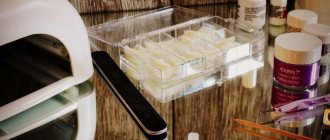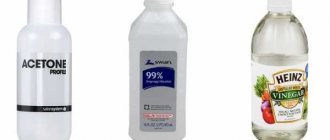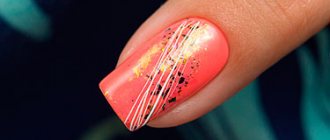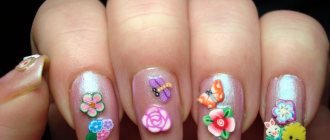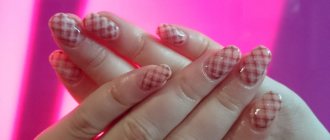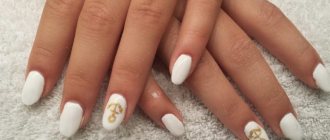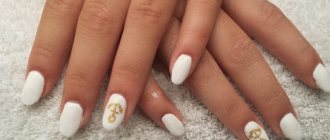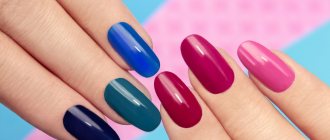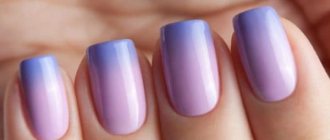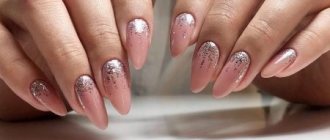New materials for nail services appear today with such frequency that even a true professional sometimes finds it difficult to keep track of all the new products. A beginner can get completely confused.
Single-phase gel for nail extensions has already become quite popular and has acquired an enviable number of fans both among certified specialists and among those who are taking their first steps in understanding the intricacies of this beautiful art. Our article will help you understand all the intricacies of the technology for those who decide to learn how to use single-phase gel for nail extensions, what kind of material it is and what are the features of working with it.
Why is the gel called single-phase?
To find the answer to this question, let's consider the main stages of technology. The extension is carried out in three stages:
- Applying a base coat responsible for adhesion to the surface of the natural nail.
- Shape modeling.
- Coating with a fixing layer that prevents rapid wear of the material and is responsible for the gloss (or for the velvety surface if the design involves a matte texture).
A three-phase system involves the use of three different products, each of which performs a different function. But when it comes to single-phase coating, only one material is needed. What it is? Single-phase gel for nail extensions, of course. He is able to solve all three problems.
What is camouflage gel
In the last few years, very bright nail art, on which all possible types of decorative decorations are stuck, has gone out of fashion. Neat nails of medium length, the appearance of which is close to natural, are becoming increasingly popular. To create just such a manicure, a camouflage gel is used.
Camouflage gel is an opaque material of varying consistency designed for modeling and extending artificial nails. The gel is laid out on the nail surface and polymerized in a lamp, which ensures high-quality adhesion of the natural plate to the polymer one.
Also, camouflage effectively hides possible imperfections in the nail plates and smoothes the surface.
The color of the camouflage material is as close as possible to the natural color of healthy nails. Usually these are pastel shades of peach, beige, and pink.
Material advantages
Often, a single-phase gel becomes the choice of beginners. This is the right decision, because you will have to spend money on just one jar to start getting better at extensions.
Another advantage is the consistency of the material. Compared to three-phase products, it is quite liquid, but not flowing. The gel is convenient to apply and distribute.
Many girls who have tried this type of material claim that it is very obedient, can be easily crimped and can be easily filed. This means that this gel is also suitable for complex arched shapes, such as a pipe.
For many who decided to find out what it is - single-phase gel for nail extensions, the discovery was the huge selection of colors. Manufacturers offer not only classic white, pink and transparent gels, but also a whole palette of camouflages, as well as luxurious opal options, gels with shimmer and sparkles, and luminescent materials. In the palettes of many brands you can easily find gel of any color.
It’s not difficult to understand how to use single-phase gel for nail extensions. If you have experience working with three-phase materials, you will probably enjoy the process. But even if this is your first attempt, you can count on a good result.
However, you should not be deceived and wait for a miracle. Working with any materials for gel manicure has many nuances. If you have the desire and opportunity to take a training course, be sure to do so. Well, if this is not possible (or you even consider nail extensions as a hobby), get ready for hard work. Follow our advice, perform each operation carefully, train and study - then everything will definitely work out.
Necessary tools and aids
Apply the single-phase gel using a flat brush with a rounded end made of synthetic bristles. Natural is not suitable for these purposes. When choosing a brush, place it on the nail of your little finger and press lightly: it should not go into the side rollers.
To dry gels, it is best to use hybrid lamps with a power of at least 36 watts.
You can’t do without forms, lint-free napkins and a cleaner. The most important tool after a brush, perhaps, can be considered a file with an abrasiveness of 100\180 grit. Some craftsmen use a machine with a suitable cutter for sawing, but this requires considerable skill.
What is UV gel for extensions
UV gel received this name due to the fact that it undergoes polymerization only in an ultraviolet lamp. Regarding this, it is not recommended to use LED or hybrid devices to avoid damage to the decorative coating.
The gel is used for classic nail extensions, regardless of the planned length and shape. However, sometimes nail technicians use it for basic strengthening of thin, weakened nails before performing a manicure.
UV gel can be single-phase or three-phase. The classic three-phase version includes three compositions:
- Base. To increase adhesion with decorative coating.
- Modeling. For direct lengthening of the free edge, correction of its shape and style.
- Finishing. A fixing layer that provides gloss on the surface and fixation of the main pigment.
The most common option now is single-phase, since it combines three compositions at once, creating a dense coating on natural nails in 1-2 applications. However, many nail technicians still prefer the three-phase technique, believing that it is more effective in their work.
Preparing the nail plate
If the material comes into contact with the pterygium, cuticle or skin, detachments cannot be avoided. Therefore, the preparatory stage is extremely important. There are no special recommendations when working with single-phase gel: do your manicure in the same way as you would before working with any other material.
Thoroughly clean the nail from the pterygium, move it back, cut and polish the cuticle with a ball-shaped cutter, and treat the areas adjacent to the side ridges. File the ends with a file with an abrasiveness of 180 grit. Polish the surface of the nail plates with a buff, carefully remove dust, wipe the nails with a lint-free cloth soaked in a special cleaner.
Experts do not recommend using pharmaceutical products with alcohol. This component is quite aggressive: it can dry out the skin or react with materials, which will complicate the work and ruin the result.
SECRETS OF NAIL WORK WITH RUNAIL COATINGS AND TOOLS
Today we will analyze the main points of the technological process of the work of nail service masters. How to choose the right cutters for hardware manicure, how to combine them correctly, how they differ, and even how to repair a nail at home. Our new article is a reference book for any master. A RuNail brand technologist will tell you the main nuances of the work in a simple and easy way. Beginners will learn a lot of useful tips from it, and experienced experts will be able to test their knowledge and, perhaps, learn new life hacks. We wish you pleasant viewing!
Hardware manicure.
Video author: @runail_pro
You can repeat this image using original and similar materials and decor using the links:
- RuNail diamond cutter;
- Crystal cutter diamond flame VladMiVa;
- RuNail diamond cutter;
- RuNail silicone carbide cutter for polishing;
- RuNail orange sticks.
Let's disassemble the flame and drop cutters into parts: tip, cheek, belly and base. Regardless of the type of nail plate, in the area under the cuticle we always work with that part of the cutter called the “cheek”, and it ideally cleans the side ridges and under the cuticle. The tip is the most dangerous part in a cutter; it is practically not used, and in those cases when it is used, in no case do you put pressure on it. The belly is also practically not used, only sometimes for processing the side ridges. When we process a nail with a cutter, the cheek must be applied to the nail plate. If we work with the tip, there is a possibility of sawing through the nail plate. If we apply the belly to the nail, we will cut through the nail plate with it, and at the same time tear the skin near the cuticle with the tip. Therefore, it is very important to control the position of the cutter during manicure. We advise beginners to practice a hardware manicure on themselves first, so that you can see from all sides whether you have applied the cutter correctly.
It is important to choose a medium-sized ball for cutting cuticles. If it's too big, you won't be able to see what you're doing, and if it's too small, it can damage your skin. The ball itself can also be divided into parts: tip, cheek and diameter. Anything below the diameter (the widest part) is not used in manicure. For a high-quality cut, the cuticle skirt is made only in diameter. If we do this with the cheek, the cuticle will simply rise to the top, but will not be cut off. And if we use the tip for this, the cuticle will fall down, turning inward, or there will be a possibility of leaving a cut on the skin.
There is a gradation according to the notches on the cutters: yellow - the softest, red - medium, blue - medium hard, and green, the hardest, which is not used for manicures. Don't forget to pay attention to them: if you process, cut and polish the leather with hard cutters, it will remain disheveled. Therefore, it is very important to monitor the gradation: if you process the skin with a blue cutter, then you need to cut it with a red cutter and use a soft polisher, or do all stages of the manicure with soft cutters.
The very first thing we do is treat the area under the cuticle with an orange stick or a hand tool like a pusher. Use a stick to slightly crawl under the cuticle and turn it up. The most important thing is to separate the cuticle from the nail plate without leaving any glue. This pocket is needed so that you can later process it with a milling cutter without any problems.
It is more convenient to start processing from the side rollers, pressing them with your thumb for better visibility. Moving on to the cuticle, it will be much easier to fall into a clean roller than into an untreated one. Movements should be short and dashing. Otherwise, you will not be able to control the pressure and will most likely make a cut. Under no circumstances should you immediately dive deeply with the cutter into the center of the cuticle.
The average number of revolutions when working with a cutter is 15-17 thousand. If you are not confident in yourself or are working with very delicate skin, they can be reduced. And if the skin is quite rough and you want to put pressure on the cutter, then it is better to increase the speed. To lift the cuticle and make it easier to cut, you need to turn the cutter over, tilt it onto the cuticle and flatten it into thin parchment.
After we are sure that everything is cleanly processed, we move on to the cut. The cuticle is cut the same way it grows, in a semicircle rather than in a straight line. After cutting the cuticle, it must be polished to smooth out all the scales. We always work with polishers at a speed of no more than 5 thousand revolutions, because they tend to heat up. At the end of the work, use a degreaser to remove all dust from under the cuticle and side rollers.
Elastone Gel.
Video author: @runail_pro
You can repeat this image using original and similar materials and decor using the links:
- RuNail bond primer;
- RuNail rubber base for gel polish;
- RuNail Elastone Gel acrygel;
- RuNail liquid for working with acrygel;
- RuNail Top Coat is a glossy topcoat without a sticky layer.
The bond and primer serve as a degreaser for the natural nail plate and do not need to be applied to the regrown material. To make the elaston easier to level, you need to work with the belly of a damp brush. If it is dry, the elastone will stick to it. And if it’s too wet, all that’s left is a puddle of wet material. We apply the base in the first thin layer to the regrown part of the plate using rubbing movements. First, we pull the elaston towards the crack that we want to repair, then we lead it to the free edge.
With the second layer we are already leveling the architecture. We try to distribute it so that it disappears towards the side rollers, and we don’t have to cut down much. We work in the same way with the surface of the nail near the cuticle. Before sending it for polymerization, we make sure to check the architecture so that we don’t have to fix everything later. Next, we proceed to sawing the free edge, using the file slightly from below. Using a ceramic cutter, we file down the natural nail plate from the inside, removing the thickness that was added. Be sure to sand the surface with a buff, degrease the nail plate and cover it with top or color.
Removing artificial turf.
Video author: @runail_pro
You can repeat this image using original and similar materials and decor using the links:
- RuNail ceramic cutter;
The perfect removal of the coating determines how well you will be able to apply a new one, be it gel polish or gel. Ceramic cutters are designed more for removing soft materials, such as gel polish, bio-gel, elastone. When working with gel or acrylic, they will become dull very quickly. And don’t forget to change cutters on time, because the speed and quality of material removal directly depends on their condition.
Mills for removing material also differ in cutters: soft red, harder blue, and the next hardest ones are green and black, but they are usually not used. The corn-shaped cutter is convenient because it has a wide belly, which is convenient for removing material, and a fairly narrow, but not sharp tip in order to get as close as possible to the cuticle and side ridges without damaging the nail.
We start with the side rollers, using light strokes with the cheek of the cutter, since the material lies there in a very thin layer and there is a possibility of sawing through the nail. We cut down the entire middle with long movements with the belly of the cutter, slightly retreating from the cuticle and to the free edge, since in the middle the material always lies in a thicker layer than on the sides and near the cuticle. If we file down the middle of the nail with the same shading movements as near the side ridges, then we will have pits on the surface, but we need it smooth. We always remove the right corner of the nail from the side roller to the center, and if we act in the opposite direction, we risk sawing through the free edge.
Next, we remove the material from the cuticle using the cheek cutter from right to left with light strokes without pressure. On the right side of the nail, near the side roller, we remove the material in the same way: with the cheek, using strokes towards the cuticle. We remove the coating at maximum speed, because the lower it is, the stronger the cutter will cut into the nail plate and the higher the likelihood of cutting the material unevenly. The minimum value at which the coating can be removed is 15 thousand revolutions.
When removing material from the free edge, we place the cutter perpendicular to the nail. We cut down the material detachments along its border with the tip of the cutter. Removal is always checked according to two points: a side view (the nail should have a smooth transition from the cuticle to the free edge with a slight elevation in the middle without bumps or pits) and a view from the end (it should be perfectly thin without sagging on the sides, without pits or bumps) . You can leave the material only in two cases: if you are going to lift the pecking nail, or to cut out the natural nail from the inside.
Modeling without filing.
Video author: @runail_pro
You can repeat this image using original and similar materials and decor using the links:
- RuNail bond primer;
- RuNail rubber base for gel polish;
- RuNail disposable nail forms;
- RuNail camouflage UV gel;
- RuNail camouflage UV gel;
- RuNail Top Coat Mat Non Sticky matte top without l/s.
Apply the primer very carefully: if you pour it on the nail, then, most likely, a detachment will appear in this place. The result of the extension depends significantly on how you set up the form, so do not neglect this process. To make the shape stand as perfectly as possible, cut out cat ears on the sides. This will help release the side rollers and press the mold more tightly. While preparing the mold, do not remove it from the backing to avoid getting it dirty with your fingers. Do this only when you are sure of its evenness.
Before starting extensions, carefully coat the nail plate with a thin layer of gel. The junction of the natural nail and the extended one must be well strengthened, as it is more susceptible to breakage and chipping than others. Try to immediately pull out the material as evenly as possible, so that later you have to cut it less. Despite the fact that we do modeling without filing, the substrate needs to be filed down. The point is to place the material as perfectly as possible and simply trim the free edge, as if it were your own nail.
Pay special attention to the growth points: under no circumstances should you saw through to the nail plate; a small thickness of the gel should remain.
Restoration of the architecture of the natural nail plate.
Video author: @runail_pro
You can repeat this image using original and similar materials and decor using the links:
- RuNail bond primer;
- RuNail rubber base for gel polish;
- RuNail camouflage UV gel;
- RuNail Top Coat is a glossy topcoat without a sticky layer.
To prevent the nail from curling, apply the first layer of gel to the tip of the nail and stretch it to the sides. With the second layer we already align the architecture.
Repairing the corner of the nail using a base.
Video author: @runail_pro
You can repeat this image using original and similar materials and decor using the links:
- RuNail base+finish for nail extensions;
- RuNail disposable nail forms;
- RuNail liquid Cleanser Plus;
- RuNail lint-free wipes.
Nail repair at home.
Video author: @runail_pro
You can repeat this image using original and similar materials and decor using the links:
- RuNail bond primer;
- RuNail rubber base for gel polish;
- Patrisa Nail acrylic powder to strengthen the free edge;
- RuNail orange sticks;
- RuNail liquid Cleanser Plus;
- RuNail file-buff;
- RuNail disposable nail forms;
- RuNail lint-free wipes.
Strengthening thin nails.
Video author: @runail_pro
You can repeat this image using original and similar materials and decor using the links:
- RuNail rubber base for gel polish;
- Patrisa Nail acrylic powder to strengthen the free edge;
- RuNail lint-free wipes;
- RuNail liquid Cleanser Plus;
- RuNail file-buff;
- RuNail orange sticks;
- RuNail rubber topcoat for gel polish without l/s.
After applying the composition of acrylic powder and base, do not forget to immediately wipe the brush with a lint-free cloth with a cleanser, because it dries easily in the air and can clog the bristles of the brush.
Preparing the nail plate for applying gel polish.
Video author: @runail_pro
You can repeat this image using original and similar materials and decor using the links:
- RuNail file-buff;
- RuNail liquid Cleanser Plus;
- RuNail lint-free wipes;
- RuNail bond primer.
By following these simple conditions, your work with RuNail materials will be easy and enjoyable
Primer: why you need it, which one to choose, how to use it
Some masters consider this stage optional. But if there are no obstacles (for example, allergies), it is better to use a primer. It acts like double-sided tape, reliably adhering the material to the surface of the nail.
The primer also solves other problems: eliminates excess moisture, prevents the development of infections, degreases, and slightly dries the surface.
There are so-called acidic and acid-free products. In fact, both contain acids, but in the second their content is lower. This option is suitable for treating nails before applying polish.
And before applying single-phase extension gel, nails must be coated with an acid primer. It is important that the material does not come into contact with the skin. The product dries in air, it does not need a lamp. You can begin further stages of coating in a minute. But if more than half an hour has passed since applying the primer, the procedure must be repeated. Therefore, there is no point in covering all 10 nails before starting work.
Review of popular products
Which single-phase gel for nail extension is better? There is no definite answer to this question; each master has his own favorites. But we can highlight several products, the reviews of which are the most numerous.
- RuNail can be called one of the most popular. Available in several shades, it files and presses well, and is well suited for beginners. Course teachers often choose this material: nail extensions with RuNail single-phase gel are discussed step by step during training. It is suitable for professionals with a lot of traffic, and for those who only do their own nails. Low cost is one of the advantages of the product. A jar of 15 grams will cost on average 250-300 rubles.
- Formula Profi is a brand loved by many craftsmen. For a jar of single-phase gel “A-Profi” you will have to pay about 450 rubles. Once polymerized, the gel turns into a very durable monolith. It is easy to file and does not create a large amount of flying dust.
- UV Lina is a product that many craftsmen who are passionate about shopping on Chinese sites have become familiar with. The cost of one jar weighing 15 g is only about 100 rubles. Reviews about this product are extremely contradictory. Some claim that the single-phase gel for nail extension “Lina” copes with the tasks perfectly. But there are also those who warn potential buyers against the terrible smell, poor packaging, and allergic reactions.
- Cosmoprofi gel is available in several shades. It is loved by manicurists due to its comfortable consistency of medium viscosity, average price (350 rubles / 15 g), and good wearability.
- Irisk single-phase gels are praised by many for their lack of odor and large palette of shades. But in reviews, some note a runny texture, due to which the material tends to flow. Not everyone is happy that the time stated by the manufacturer is not enough for polymerization.
Extension on forms
Let’s make a reservation right away that this material is not suitable for the top forms that are fashionable today. Only classic lower forms can be used.
There's no need to rush. If you have little experience yet, work with each finger separately, drying each layer. Before you start using single-phase extension gel, nails should be thoroughly treated, degreased and coated with primer.
- Adjust the shape to the nail, making cuts if necessary so that the base fits as tightly as possible.
- Carefully glue the edges together, making sure that all symmetrical elements match completely. You can use a stationery stapler to prevent the form from coming unglued while working.
- Using rubbing movements, apply the first base layer of single-phase gel, starting from the end and moving towards the cuticle. Avoid contact with skin! If the gel is baked on the cuticle, detachments are inevitable.
- Cure the material in the lamp for as long as the manufacturer recommends. Evaluate the result by lightly tapping the surface with a pusher.
- Place a drop of gel on the mold, where the free edge will form. Use confident strokes to distribute the material, following the markings. Shape the apex depending on the desired length. Place in a lamp to dry.
- Carefully evaluate the surface, if necessary, add a little gel to the gaps. File off unnecessary bulges with a file. If you don't plan on doing the design, simply cover the nail with another thin layer of gel, turn your hand over, palm down, and let the material level out. Send the work back to the lamp.
- You can start sawing. Follow the direction of the side edges, check the symmetry of the nail. Single-phase gel does not need a topcoat, but you can use, for example, a satin or velor finish for decorative purposes.
- All that remains is to remove the dust and remove the stickiness with a special product.
Advantage of extension
Before you decide to do your own nail extensions, you need to study the advantages of this event , and of course, do not ignore the disadvantages. Let's look at the positive aspects:
- The procedure is easy: after several trainings, extensions are available to any savvy girl who has not previously had anything to do with nail procedures.
- With the help of the gel, it became possible to give your nails a well-groomed appearance and hide small defects in the plate.
- The gel does not emit any odor either during application or during wear.
- Most manufactured gel products contain a safe composition . The gel does not cause general allergic reactions: individual intolerance is possible.
- Gel extensions are considered one of the most long-lasting: nail plates are difficult to damage due to the thick layer of artificial material.
- Extended nails look beautiful and aesthetically pleasing: skillful and careful extensions do not distinguish artificial nails from natural nails.
Another main advantage that requires special mention: gel extensions help overcome the habit of biting fingers and free edges of the nail plate. After the first wear you can see the result.
As with any cosmetic procedure, there are several disadvantages , which we will discuss below:
- Materials and tools for extensions are quite expensive : it cannot be said that the procedure will be much cheaper than in a salon. Savings occur due to the exclusion of payment to the master from the pricing chain.
- Extensions damage the nail plates, despite the fact that almost all masters convince you otherwise. A long absence of oxygen access to the nail plates cannot have a positive effect on the tissues of the body.
- Do-it-yourself nail extensions take 1.5 times longer to do in a salon. This is due to the inconvenience of applying the composition to the non-dominant hand.
- Too frequent correction - the extension becomes visually unusable already in the third week of wearing.
- If extensions are not applied correctly, voids may form under the nail plates. This is a potential focus for the development of infectious inflammation.
When making a decision, weigh both sides of the scale: think about whether you are ready to sacrifice time or the health of your nails for the sake of a beautiful shape and well-groomed hands.
Polymerization time
Always pay close attention to the manufacturer's recommendations if you have purchased a new single-phase nail extension gel. How to use the material, how long to dry the layers and other recommendations - all this is usually indicated on the packaging. On average, it takes 1-3 minutes to dry the gel in a hybrid lamp for each layer.
How to use UV nail gel
To extend artificial nails with UV gel, at least minimal knowledge of technology is required. Below is a short tutorial. But we recommend attending special courses, or browsing one of the popular video hosting sites in search of video tutorials.
So, let's look at how to use UV nail gel. Let's focus specifically on the three-phase extension system. We will need: a brush for modeling gel nails, primer, degreaser, lint-free wipes, file for natural nails, buff, file for artificial nails, base gel, modeling gel, finish, bottom paper forms, nail decor (take rhinestones).
- We process the nails and do a trim manicure according to this pattern.
- We file natural nails and clean them well with buff. We remove dust and degrease.
- Carefully apply the primer strictly to the nail plate, trying to cover it completely. Place your nails in a UV lamp for 2 minutes.
- We attach a paper form for modeling artificial nails.
- We create a frame using the base gel and dry it in a lamp for 2 minutes.
- We remove the form, carefully file the resulting frame, giving it the desired shape.
- Apply modeling gel and make a seal in the middle of the nail plate. To do this, the UV gel should be scooped up with a ball. We don't dry it.
- Sprinkle glitter of the desired color onto the tip of the nail (on the wet gel). We send the nail to dry in a UV lamp for 2-4 minutes.
- We cover the nail with the finish, remove the sticky layer with a degreaser and file on all sides (including the top), achieving the desired shape (perfecting it).
Design options for gel nails can be found here and here.
If you read modern publications writing about fashion, you will notice many articles that emphasize all the advantages of UV gel, which is still one of the most popular nail extension systems. Even Hollywood celebrities actively use it. Widespread use, accessibility, and most importantly - an ideal result that pleases the wearer of neat nails - all this is the chic transformation that your fingers deserve.
Don’t be afraid to constantly experiment and try something new, because changes in your image always bring changes in your life!
Why does the gel bake in the lamp?
In reviews of single-phase nail extension gels, you can often find indignation about burning during drying. This occurs due to the fact that the material passes from one state of aggregation to another, crystal lattices are formed. Chemical processes are accompanied by the release of heat.
It is enough to simply reduce the lamp power (if this function is provided by the equipment manufacturer). When working with unregulated lamps, you can simply remove your hand for a few seconds, allowing the heated material to cool slightly. As soon as the gel “sets”, the burning sensation will go away.
It should be understood that this is not a lack of material, but a technological feature.
Transparent gel Lina reviews
26 product reviews
Write a review
Marina's answer
If you treat your nails well with a primer, then you can apply this gel without a base, I do this and there are no peelings, it’s a good gel.
This is a single phase gel, can it be used as a base?
otseka
The gel is super, I order it for the second time, the shine is excellent, it hardens in 2-3 minutes and stays on the nails for a very long time)))
Pigment for gel
I also add pigments to the gels. I immediately raised the price for such extensions by 2 times - like the gel is more expensive and all that, I buy only cheap gels, and the pigment in the jar is enough for 5 years for sure, you need very little of it per jar :)))))))) ))))))
Re: Pigment
I ordered pigments from this store, here https://www.gilina.ru/index.php?categoryID=400&offset=20
I add just a tiny one, about the size of a match head, if it’s transparent, it’s twice as big in white, it looks cool!
Pigment
Girls, I’m sorry, I just don’t know what “pigment” is, where do you buy it, if possible, give me a link)) And can you be more specific about how much to add to get beautiful extensions?
I love this gel!
it gives good shine and a minimum of shrinkage, when I extend nails on forms, then before extensions I put the gel in the freezer for 15 minutes, it becomes thick and sticks well to the forms, does not spread at all. And I add a little pigment to the jar and mix, beautiful.
pigment
How do you add glitter pigment to this gel?
Gel for nail extension
I like this gel too! While there are discounts on Gilina, I ordered 10 pieces of this gel!
cool extension gel
cool! I always take only this gel!
and I liked it
I don’t know, everyone scolds Lina-Gina, well, I tried it, but it’s not all that different from expensive gels, the cost of extensions is super, although it burns in the lamp more than others, well, that’s okay, tolerable.
Common questions and answers
Most often, beginners wonder whether it is possible to use products of a three-phase system as a single-phase gel. Unfortunately this is not possible. But a single-phase one is suitable instead of a modeling or finishing coating.
It is highly undesirable to use this material for French lay-outs. In any case, you will need at least two gels of different colors, so what is the point of using a single-phase one? It is much easier to use a three-phase system.
Doubts are often raised about the possibility of using a single-phase gel to strengthen nails without extensions. The material is excellent for these purposes. It can be used as a base for gel polish and for repairing broken nails.
The most popular gel paints
The most popular helium varnishes include products from the following brands:
- RuNail. Gel polishes are packaged in cute round jars and oblong tubes of different colors: white, pink, red, green and others. The paints have a thick consistency, good pigmentation and are suitable for beginners. The same brand produces gel polish with glitter in a jar.
Varnish in a jar RuNail
- Kodi Professional. This company produces high-quality thick gel paints that are suitable for creating various decors. Available in small round black jars. The palette includes 63 colors. The disadvantages of this product are the lack of a sticky layer, which makes it impossible to use the casting technique, and the volume of the jars is too small. Kodi Pofessional gel paint is used both in professional beauty salons and at home.
Kodi Professional
- Emi. This is a German company that produces high-quality and expensive gel paints. They are produced mainly in pink tubes. Emi helium paints are combined into 15 collections. Among them there are classic glossy and pearlescent paints, acid-bright and calm, powdery ones.
Gel paint Emi
- Canni. Products from the Chinese manufacturer Canni can be ordered on Aliexpress. It is ideal for beginners. Gel paints from Canni have a liquid consistency, like gel polishes, and require several layers to obtain a rich color. Chinese gel paints are produced in round small jars of a light beige shade.
Gel paint Canni

